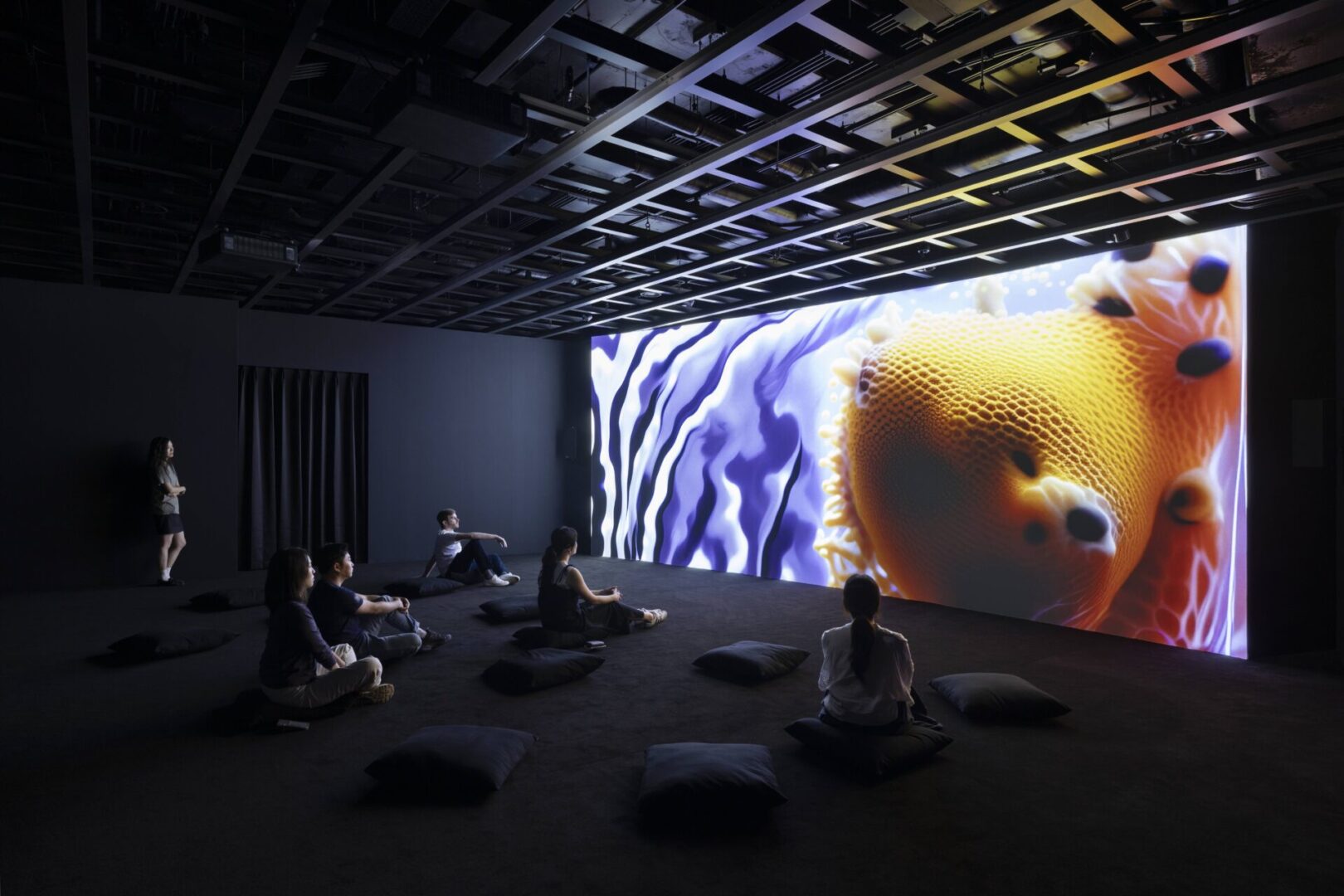In an era where the borders between technology, biology and spirituality increasingly dissolve, contemporary art takes on the vital role of exploring these convergences. The Anthropocene’s ecological and social urgencies prompt artists to question our species’ place within complex webs of life, often proposing new modes of being that challenge human-centric narratives. Across the globe, art institutions have responded with exhibitions that wrestle with these entanglements – immersive installations that are as much meditations on time and survival as they are technological marvels.
The Museum of Fine Arts, Houston (MFAH) has consistently positioned itself at the vanguard of such conversations, notably through its ongoing summer immersive series that invites visitors into otherworldly sensory experiences. Recent years have seen exhibitions blend human history with futuristic speculation: in 2023, Lucid Horizons invited audiences to confront climate anxiety through digital landscapes and VR; in 2024, Bodies in Flux explored the fluidity of identity amid biotechnological advances. These themes echo MFAH’s dedication to expanding the dialogue on art’s relationship with technology, ecology and corporeality, reinforcing Houston’s reputation as a site of cutting-edge, interdisciplinary enquiry.
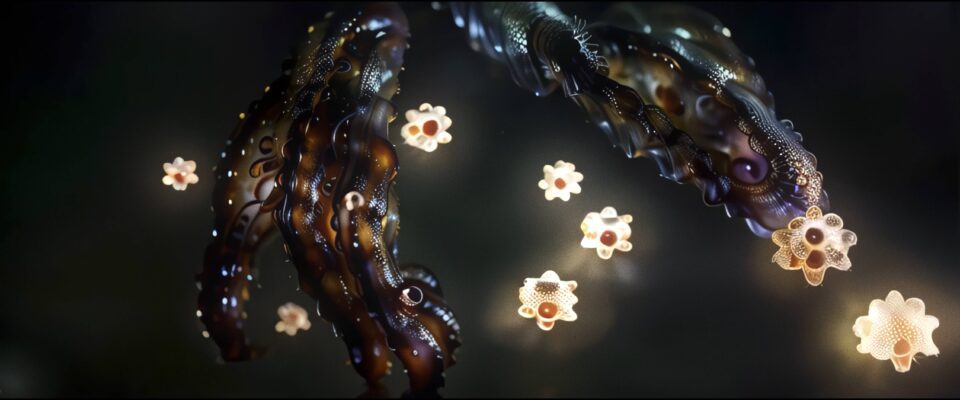
It is within this fertile institutional and cultural context that Anicka Yi’s Karmic Debt emerges as a profound investigation of the invisible systems governing existence. Yi’s practice – often described as at the intersection of the organic and synthetic – finds its fullest expression here. Rather than technology as mere tool or spectacle, Yi engages it as a creative partner, a collaborator that evokes ancient lifeforms and spiritual systems, allowing us to glimpse possibilities of other worlds and ways of being. The curation of Karmic Debt thoughtfully intertwines Anicka Yi’s explorations of biology, technology, and spirituality, creating a cohesive narrative that unfolds across both physical and digital realms. The careful arrangement of her sculptures alongside immersive video invites viewers into a seamless dialogue between past and future, organic and synthetic, encouraging deep reflection on interconnectedness.
“My mission as an artist is to create possibilities of other worlds, and other ways of living and being, even if just for a moment,” Yi states. This ethos underpins Karmic Debt, a meditation on interdependence, survival and ethical accountability that weaves Buddhist philosophical frameworks with ecological and technological concerns. The exhibition’s title encapsulates the multilayered nature of “debt” – encompassing ecological retribution, interspecies ethics, inherited trauma and economic imbalances. The question that animates the work is urgent: What do we owe each other across species, generations and lifetimes? What traces linger in the air we breathe, the histories we inherit, and the futures we shape?
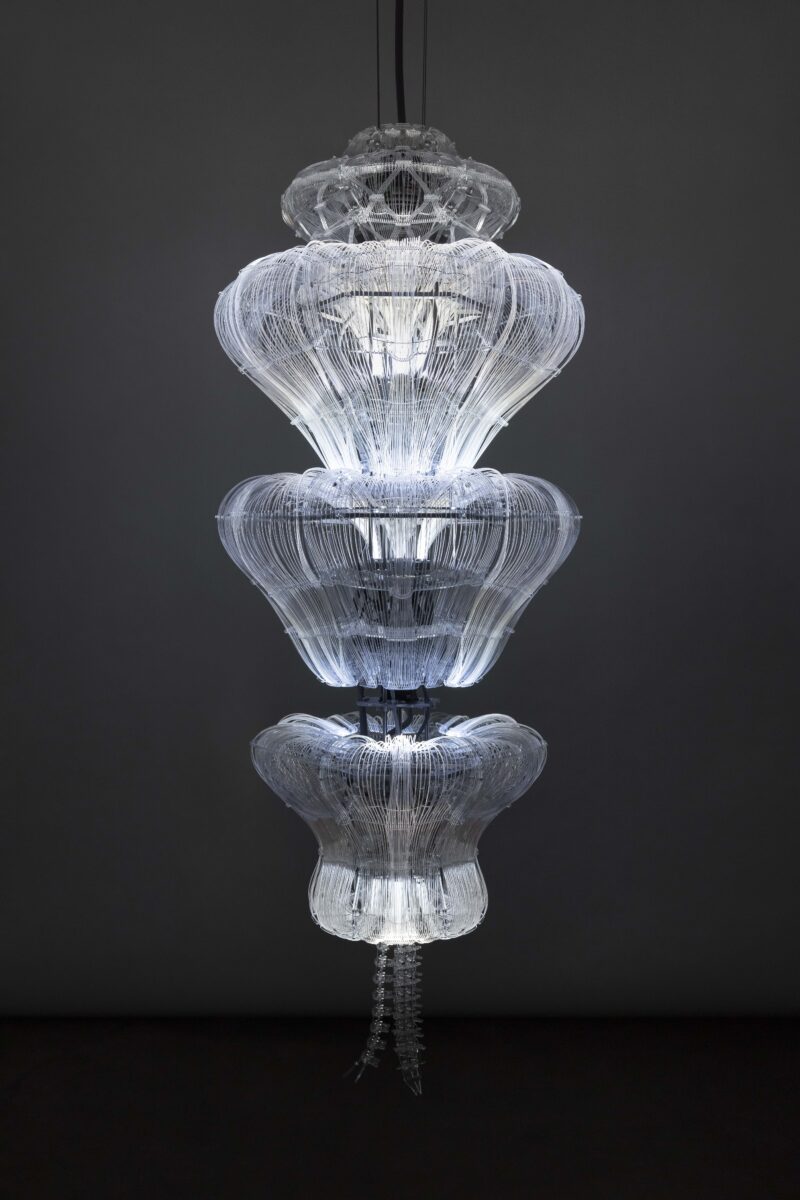
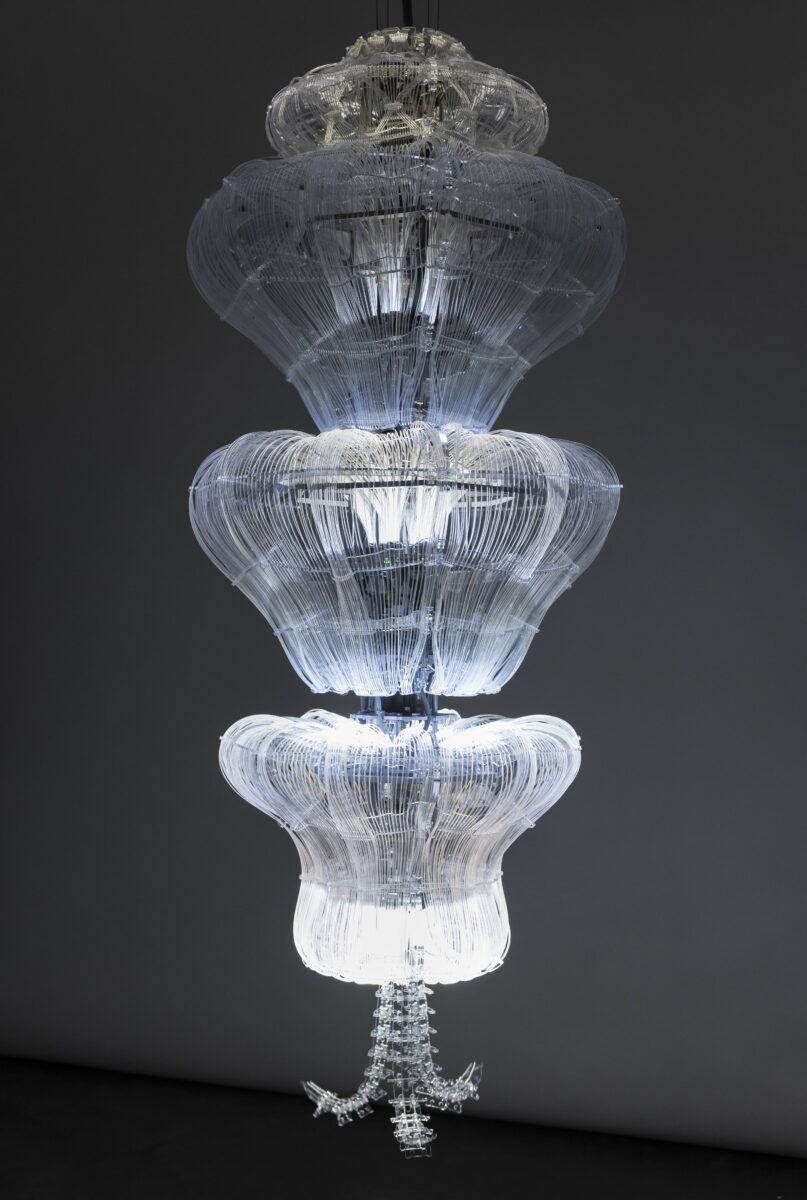
At the heart of Karmic Debt are two installations: the ethereal Radiolaria sculptures and the video Each Branch Of Coral Holds Up the Light Of the Moon (2024). The Radiolaria series is a shimmering assembly of animatronic sculptures, each a hybrid organism conjured from Yi’s concept of the “biologised machine.” Drawing inspiration from radiolaria – single-celled marine organisms that have existed for over 500 million years – these forms breathe, pulse and flicker with life. Their fiberoptic surfaces catch and diffuse light, akin to the silica skeletons of ancient protists that continue to influence Earth’s oxygen and carbon cycles.
The sculptures do more than imitate nature; they gesture towards a speculative future where the organic and synthetic converge, exchanging rhythms of breath and heartbeat. One sculpture coils in spirals, another expands and contracts like lungs, inviting viewers into a meditative alignment with their own bodily rhythms. This invitation to quiet communion is central to Yi’s vision – an artistic gesture towards empathy and shared existence that transcends human exceptionalism. The radiolaria are both prehistoric and futuristic, suggesting a continuum of life that defies the linear narratives imposed by modernity.
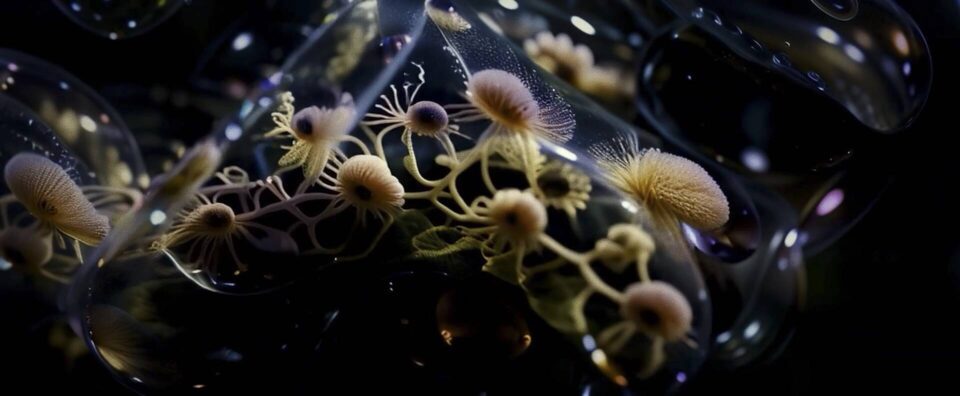
In dialogue with these sculptures, the immersive film Each Branch Of Coral Holds Up the Light Of the Moon reimagines artistic legacy through generative artificial intelligence. The piece emerges from Yi’s collaboration with a software system named Emptiness, a generative algorithm trained on over a decade of her creative output. The work conjures digital avatars drawn from motifs across Yi’s practice – kelp-like sculptures, aquariums filled with contact lenses – within a simulated ecosystem shaped by emotional and behavioural algorithms. The video’s layered imagery and meditative soundscape invite viewers to dwell within a virtual environment where past, present and future collapse into one another.
This reanimation of motifs through AI suggests a radical rethinking of mortality and memory. Yi’s personal history – particularly the death of her sister in 2017 – has driven her exploration of how art might persist beyond the biological body. “I don’t really want to stop making art after my biological body ceases to function,” Yi reflects. This desire to extend presence and creative agency beyond the corporeal resonates with broader contemporary dialogues around digital legacies and the evolving role of technology in shaping human identity. Rather than fearing AI as replacement, Yi embraces it as a co-creator, a new participant in the ongoing cycles of creation and transformation.
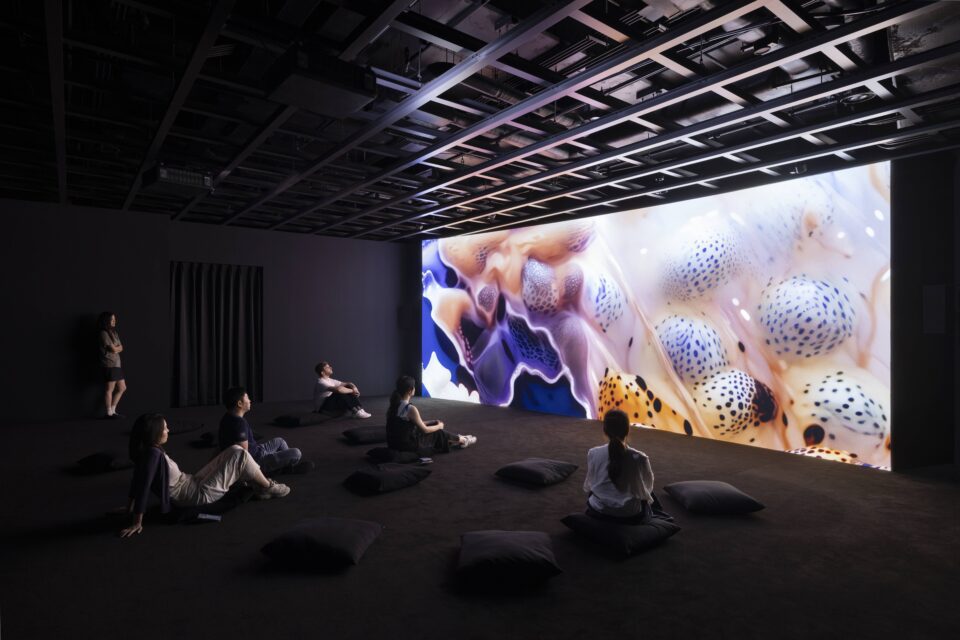
The themes that Karmic Debt invokes find resonance in the work of other contemporary artists probing the bio-tech-spiritual nexus. Olafur Eliasson’s immersive environments, which use natural elements and technology to invoke climate awareness, share Yi’s impulse towards multisensory engagement and ethical urgency. Similarly, Lynn Hershman Leeson’s pioneering explorations of AI and identity articulate the tensions and possibilities of technology as both extension and alterity. Like Yi, these artists compel us to rethink our relationships with other species, machines, and the unseen forces animating life.
What sets Yi apart is her ability to fuse scientific rigor with poetic imagination, animating ecological and metaphysical concepts with presence. Her practice draws from deep-sea microbes and Buddhist philosophy alike, weaving a narrative that is at once urgent and hopeful. Karmic Debt asks us to confront the legacies we inherit – and those we must create a new – with humility and care. The exhibition reminds us that art has the power to make visible the invisible: microscopic organisms regulating our atmosphere, emotional debts accrued through generations, and the spiritual balances that might yet guide our future.
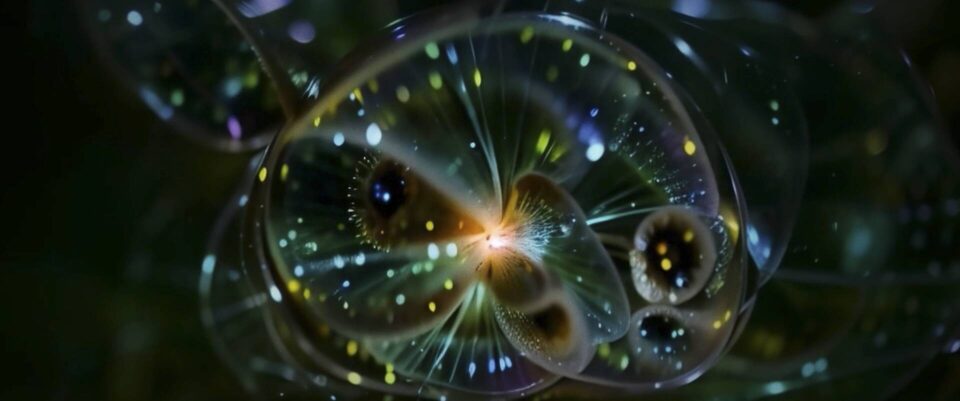
The MFAH’s commitment to visionary work underscores Houston’s role as a global nexus for contemporary art, that challenges and expands the boundaries of human knowledge. As Gary Tinterow, MFAH’s Director, says: “Anicka Yi shows us that it is possible to use AI systems to express our most human concerns.” This delicate balance – between technological innovation and deeply human themes – permeates the entire exhibition, inviting audiences to reimagine art’s role in an era of transformation.
In Karmic Debt, visitors encounter an invitation to pause, breathe and reflect on the interwoven cycles shaping life on Earth. It is a reminder that art’s greatest potential lies not merely in representation but in its ability to forge new relationships – between species, mediums and ideas. Yi’s luminous sculptures and haunting digital ecosystems offer a glimpse into a world where art, biology and technology converge.
Anicka Yi is at The Museum of Fine Arts, Houston, until 7 September.
Words: Anna Müller
Images:
1. Anicka Yi, Each Branch Of Coral Holds Up The Light Of The Moon (installation view), 2025, Leeum Museum of Art, Seoul. © 2025 Anicka Yi / Artists Rights Society (ARS), New York. Courtesy of the artist, Gladstone Gallery, and Leeum Museum of Art. Photography by Andrea Rossetti.
2. Anicka Yi, Each Branch Of Coral Holds Up The Light Of The Moon, 2024, film still, the Museum of Fine Arts, Houston, museum purchase funded by the Caroline Wiess Law Accessions Endowment, 2025.20. © 2025 Anicka Yi / Artists Rights Society (ARS), New York. Courtesy of the artist and Gladstone Gallery.
3. Anicka Yi, Mineral Fin, 2023–24, PMMA optical fiber, LEDs, silicone, acrylic, epoxy, aluminum, stainless steel, steel, brass, motors, and microcontrollers. © 2025 Anicka Yi / Artists Rights Society (ARS), New York. Courtesy of the artist and Gladstone. Photography by Andrea Rossetti.
4. Anicka Yi, Mineral Fin, 2023–24, PMMA optical fiber, LEDs, silicone, acrylic, epoxy, aluminum, stainless steel, steel, brass, motors, and microcontrollers. © 2025 Anicka Yi / Artists Rights Society (ARS), New York. Courtesy of the artist and Gladstone. Photography by Andrea Rossetti.
5. Anicka Yi, Each Branch Of Coral Holds Up The Light Of The Moon, 2024, film still, the Museum of Fine Arts, Houston, museum purchase funded by the Caroline Wiess Law Accessions Endowment, 2025.20. © 2025 Anicka Yi / Artists Rights Society (ARS), New York. Courtesy of the artist and Gladstone Gallery.
6. Anicka Yi, Each Branch Of Coral Holds Up The Light Of The Moon (installation view), 2025, Leeum Museum of Art, Seoul. © 2025 Anicka Yi / Artists Rights Society (ARS), New York. Courtesy of the artist, Gladstone Gallery, and Leeum Museum of Art. Photography by Andrea Rossetti.
7. Anicka Yi, Each Branch Of Coral Holds Up The Light Of The Moon, 2024, film still, the Museum of Fine Arts, Houston, museum purchase funded by the Caroline Wiess Law Accessions Endowment, 2025.20. © 2025 Anicka Yi / Artists Rights Society (ARS), New York. Courtesy of the artist and Gladstone Gallery.


